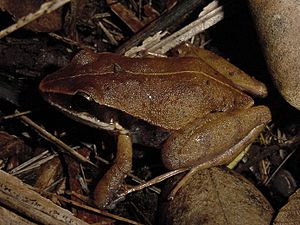Eleutherodactylus dimidiatus facts for kids
Quick facts for kids Eleutherodactylus dimidiatus |
|
|---|---|
 |
|
| Conservation status | |
| Scientific classification |
The Eleutherodactylus dimidiatus is a very special and rare type of frog. It belongs to a group of frogs called Eleutherodactylidae. This frog is found only in Cuba, which means it is endemic to that island. Imagine a creature that lives nowhere else on Earth!
This tiny frog makes its home in specific kinds of forests. It likes warm, wet places like subtropical or tropical moist lowland forests and also montane forests, which are forests found on mountains. Sadly, this unique frog is in danger because its natural habitat is disappearing. This is called habitat loss.
About the Cuban Dwarf Frog
The Eleutherodactylus dimidiatus is a small frog that was first described by a scientist named Edward Drinker Cope in 1862. Frogs like this one are amphibians, which means they can live both on land and in water. However, many frogs in the Eleutherodactylus family, including this one, don't need open water to lay their eggs. Instead, their eggs develop directly into tiny froglets, skipping the tadpole stage. This is a cool adaptation that helps them live in different environments.
Where This Frog Lives
This rare frog lives only on the island of Cuba. It prefers two main types of forest:
- Tropical Lowland Forests: These are warm, wet forests found closer to sea level. They have lots of trees and plants, and the air is often humid.
- Tropical Montane Forests: These forests are found higher up on mountains. They are also moist and green, but the temperatures might be a bit cooler than in the lowlands.
Both of these habitats provide the perfect conditions for the Eleutherodactylus dimidiatus to find food and shelter. They need the dampness to keep their skin moist and the plants to hide from predators.
Why This Frog Is in Danger
The biggest threat to the Eleutherodactylus dimidiatus is habitat loss. This means that the places where these frogs live are being destroyed or changed. Here are some reasons why this happens:
- Deforestation: Trees are cut down to make space for farms, buildings, or roads. When trees are removed, the forest habitat shrinks.
- Pollution: Water and soil can become polluted by chemicals from farming or industries. This makes it hard for frogs to survive.
- Climate Change: Changes in weather patterns, like less rain or more extreme temperatures, can also harm their delicate forest homes.
When their habitat disappears, these frogs have nowhere to go. Because they are only found in Cuba, and in specific types of forests there, they are very vulnerable. Protecting their forest homes is super important to help this special frog survive.
See also
 In Spanish: Eleutherodactylus dimidiatus para niños
In Spanish: Eleutherodactylus dimidiatus para niños


